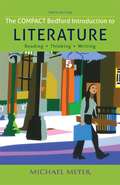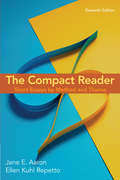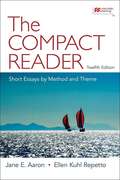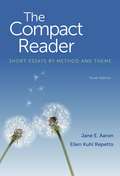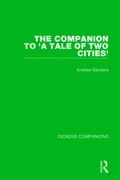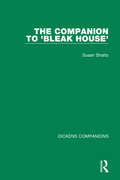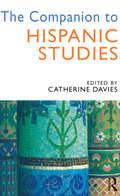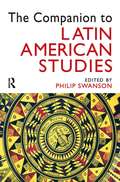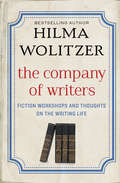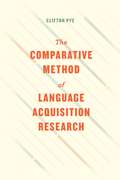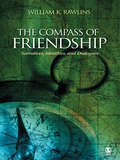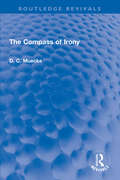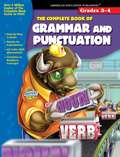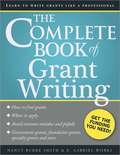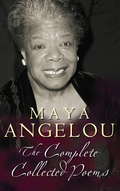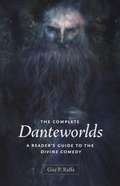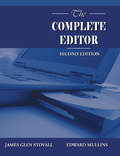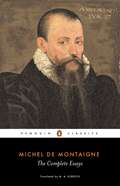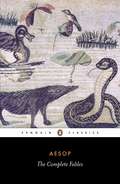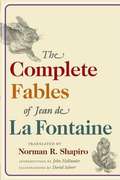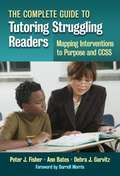- Table View
- List View
The Compact Bedford Introduction to Literature: Reading, Thinking, and Writing (Tenth Edition)
by Michael MeyerLike its predecessors, the tenth edition of The Compact Bedford Introduction to Literature assumes that reading and understanding literature offers a valuable means of apprehending life in its richness and diversity. This book also reflects the hope that its selections will inspire students to become lifelong readers of imaginative literature, as well as more thoughtful and skillful writers.
The Compact Reader: Short Essays By Method And Theme (Eleventh Edition)
by Jane E. Aaron Ellen Kuhl RepettoThe Compact Reader offers an innovative dual organization; it can be taught rhetorically or thematically. Each rhetorical method is paired with an engaging thematic topic so that readings display the full range and flexibility of writing in each mode. Selections average just two or three pages in length, so that students can read them quickly, analyze them thoroughly, and emulate them successfully. A brief guide to reading and writing, detailed chapter introductions, and two final chapters on working with sources serve as a mini-rhetoric, providing students with the support they need. For instructors who want a concise, affordable, effective resource for teaching the connection between form and content, The Compact Reader is the perfect choice.
The Compact Reader: Short Essays by Method and Theme
by Jane Aaron Ellen RepettoThe Compact Reader helps you turn in better writing assignments, using brief essays on a variety of topics to focus on specific skills.
The Compact Reader: Short Essays by Method and Theme (Tenth Edition)
by Jane E. Aaron Ellen Kuhl RepettoThe Compact Reader seamlessly combines four texts--a short-essay reader, a rhetorical reader, a thematic reader, and a brief rhetoric--into one slim volume containing three dozen engaging, high-quality essays.
The Companion to 'A Tale of Two Cities' (Dickens Companions #1)
by Andrew SandersThis book, first published in 1988, reveals the great care Dickens took with the planning and preparation of A Tale of Two Cities and its roots. It also explores the aspects of Dickens’s life, especially his interest in private theatricals, which contributed to the genesis of the novel. For the first time the historical sources for the very individual account of the French Revolution presented in A Tale of Two Cities are examined, and the book investigates the novelist’s debt to French and English eye-witnesses. This Companion identifies the multitude of allusions to what Dickens often regarded as the whims of eighteenth-century justice, religion, philosophy, fashion and society. It provides the modern reader with both fundamental sources of information and a fascinating account of the creation of a complex historical novel.
The Companion to 'Bleak House' (Dickens Companions #2)
by Susan ShattoThis book, first published in 1988, is the most comprehensive annotation of Bleak House ever undertaken. It provides authoritative background information about the topical issues of the novel that interested Dickens as a social critic and activist. It also describes the novel’s literary antecedents and identifies the sources of its hundreds of literary and historical allusions. The annotation is based on a wide range of nineteenth-century sources – from newspapers, periodicals and parliamentary papers to travel guides and cookery books – and gives the modern reader unprecedented access to both Bleak House – Dickens’s tract for the times – and the period when it was written.
The Companion to 'The Mystery of Edwin Drood' (Dickens Companions #3)
by Wendy S. JacobsonThis book, first published in 1986, explores the allusions in Dickens’s work, such as current events and religious and intellectual issues, social customs, topography, costume, furniture and transportation. Together with an analysis of Dickens’s imaginative responses to his culture, and their place in the genesis and composition of the text, this book is a full-scale, thoroughgoing annotation that The Mystery of Edwin Drood requires.
The Companion to Hispanic Studies
by Catherine DaviesWhat is 'Hispanic Studies'? This companion gives a concise and accessible overview of the discipline as taught today and suggests new directions for future developments. 'Hispanic Studies' is broadly concerned with the languages and cultures of the vast 'Hispanic' world, extending chronologically from Roman Hispania to today, and geographically from Roman Hispania to today, and geographically from California in the North to Patagonia in the South, and from Majorca in the East to the Andes in the West.This essential book provides all the necessary introductory information on the subject and will be especially useful for students who have already started courses in Spanish / Hispanic Studies, or who are considering doing so in the future.Written by a team of leading scholars each with established teaching experience this collection of short essays explores topics as diverse as the history of the Spanish language, Islamic Andalusia, race and class in the Spanish Golden Age, Catalan nationalism, the Madrid 'movida', Latin America cinema, tango in Argentina, Evita Pern, 'testimonio' and the cultural significance of the US-Mexican border. The emphasis is on literature and texts, including film and photography. In addition, the book includes time-lines, summary boxes adn suggestions for further reading.
The Companion to Latin American Studies
by Philip SwansonWhat is 'Latin American Studies'? This companion gives a concise and accessible overview of the discipline. Covering a wide range of topics, from colonial cultures and identity to US Latino culture and issues of race, gender and sexuality, this book goes beyond conventional literary companions and situates Latin America in its historical, social, political, literary and cultural context. This essential book provides the key introductory information on the subject and will be especially useful for students taking or considering taking courses in Hispanic or Latin American Studies. Written by an international team of experts, each chapter supplies the necessary basic information and a sound introduction to central ideas, issues and debates. In addition to 12 chapters on the main topics in Latin American Studies, the companion includes an introduction, time chart, glossary and suggestions for further reading.
The Companion to Our Mutual Friend: Routledge Library Editions: Charles Dickens Volume 4 (Routledge Library Editions: Charles Dickens #Vol. 1)
by Michael CotsellOur Mutual Friend (1864-5) Dickens’ last completed novel, has been critically praised as a profound and troubled masterpiece, and yet is has received far less scholarly attention than his other major works. This volume is the first book-length study of the novel. It explores every aspect of Dickens’ sustained imaginative involvement with his age. In particular its original research into hitherto neglected sources reveals not only Dickens’ reactions to the important developments during the 1860s in education, finance and the administration of poverty, but also his interest in phenomena as diverse as waste collection and the Shakespeare tercentenary. The Companion to Our Mutual Friend demonstrates the varied resources of artistry that inform the novel, and it provides the reader with a fundamental source of information about one of Dickens’ most complex works.
The Company of Writers: Fiction Workshops and Thoughts on the Writing Life
by Hilma WolitzerAward-winning author Hilma Wolitzer's expert guide to navigating a life of writing through workshops and writers' groupsWhen Hilma Wolitzer finished writing her first short story, she had no idea what to do next. She didn't trust her family members to give honest critiques, and most of her friends--though they tried to be helpful--knew little about writing fiction. But her creative life changed when she attended a local writing workshop and discovered the joys of working within an artistic community. Since good workshops and conferences are often expensive or difficult to find, Wolitzer provides a guide to building a workshop of your own. With dedication and drive, an informal writer's group can become as useful as any college course--and much more fun. Wolitzer shows how to build a group, how to make it effective, and how to keep going when a member hits a snag. She also offers solid advice on many aspects of writing and publishing fiction. Writing may be a solitary occupation, but in the company of writers, it never needs to be lonely. This ebook features an illustrated biography of Hilma Wolitzer, including rare photos and never-before-seen documents from the author's personal collection.
The Comparative Method of Language Acquisition Research
by Clifton PyeThe Mayan family of languages is ancient and unique. With their distinctive relational nouns, positionals, and complex grammatical voices, they are quite alien to English and have never been shown to be genetically related to other New World tongues. These qualities, Clifton Pye shows, afford a particular opportunity for linguistic insight. Both an overview of lessons Pye has gleaned from more than thirty years of studying how children learn Mayan languages as well as a strong case for a novel method of researching crosslinguistic language acquisition more broadly, this book demonstrates the value of a close, granular analysis of a small language lineage for untangling the complexities of first language acquisition. Pye here applies the comparative method to three Mayan languages—K’iche’, Mam, and Ch’ol—showing how differences in the use of verbs are connected to differences in the subject markers and pronouns used by children and adults. His holistic approach allows him to observe how small differences between the languages lead to significant differences in the structure of the children’s lexicon and grammar, and to learn why that is so. More than this, he expects that such careful scrutiny of related languages’ variable solutions to specific problems will yield new insights into how children acquire complex grammars. Studying such an array of related languages, he argues, is a necessary condition for understanding how any particular language is used; studying languages in isolation, comparing them only to one’s native tongue, is merely collecting linguistic curiosities.
The Compass of Friendship: Narratives, Identities, and Dialogues
by William K Rawlins2012 Recipient of the Gerald R. Miller Book Award from the Interpersonal Communication Division of the National Communication Association (NCA) <p><p> 2009 Recipient of the David R. Maines Narrative Research Award from the Ethnography Division of the National Communication Association (NCA) <p> Exploring how friends use dialogue and storytelling to construct identities, deal with differences, make choices, and build inclusive communities, The Compass of Friendship examines communication dialectically across private, personal friendships as well as public, political friendships. Author William K. Rawlins uses compelling examples and cases from literature, films, dialogue and storytelling between actual friends, student discussions of cross-sex friendships, and interviews with interracial friends. Throughout the book, he invites readers to consider such questions as: What are the possibilities for enduring, close friendships between men and women? How far can friendship's practices extend into public life to facilitate social justice? What are the predicaments and promises of friendships that bridge racial boundaries? How useful and realistic are the ideals and activities of friendship for serving the well-lived lives of individuals, groups, and larger collectives?
The Compass of Irony
by D. C. MueckeFirst published in 1969, The Compass of Irony is a detailed study of the nature, qualities, classifications, and significance of irony. Divided into two parts, the book offers first a general account of the formal qualities of irony and a classification of the more familiar kinds. It then explores newer forms of irony, its functions, topics, and cultural significance. A wide variety of examples are drawn from a range of different authors, such as Musil, Diderot, Schlegel, and Thomas Mann. The final chapter considers the detachment and seeming superiority of the ironist and discusses what this means for the morality of irony. The Compass of Irony will appeal to anyone with an interest in the history of irony as both a literary and a cultural phenomenon.
The Complete Book of Dutch-ified English: An “Inwaluable” Introduction to an “Enchoyable” Accent of the “Inklish Lankwitch”
by Gary GatesHere is a book for anyone tired of speaking flat, colorless, homogenized English. Pennsylvania Dutchman Gary Gates provides a glossary, read-aloud section, songs, recipes, and more in this delightful, ?inwaluable” introduction to Dutch-ified English.Learn the meaning of ?rutch” and ?spritz,” what a ?clod” and a ?crotch” are, how to pronounce and make ?Cussin Rache’s Snitz and Knepp,” and what has happened to food when it’s ?all.” Spice up your vocabulary with delightful words and phrases, such as:? Grex: To complain, moan. ?Ah, quit your grexing, you have a vonderful life.”? Face: Belief, religious conwiction. ?Praise be! Rebecca has found her face in the Lord again!”? Gruntbecky: An expression of hard going. ?Gruntbecky! It’s difficult to run in this hot sun.”? Nix nootz: A devilish, mischievous person. ?Our daughter is a little nix nootz.”? Rupdawn: A massage. ?A good rupdawn will take the ache away.”Tired of trying to conform to traditional speech patterns, Gary offers a warm and funny celebration of the unique Dutch culture in America.
The Complete Book of Grammar and Punctuation: Grades 3-4
by Carson-Dellosa Publishing Staff American Education Publishing StaffThe Complete Book of Grammar and Punctuation provides 352 pages of fun exercises that teach students in grades 3 and 4 key lessons in foundational English language skills!
The Complete Book of Grant Writing
by Nancy Burke Smith E. Gabriel WorksGet the funding you need! Grant writing is an intricate process, and any bits of misinformation or formatting errors can be the deciding factors when it comes to allotting money. The Complete Book if Grant Writing is a must-have reference if you're seeking funding through grants-government grants, foundation grants, specialty grants, and more. Professional grant writer Nancy Burke Smith and philanthropy consultant and grant maker e. Gabriel Works unveil the secrets behind how to find and successfully apply for grants. The Complete Book of Grant Writing includes information on: *The Five Core Components of every grant, including the statement of need, the evaluation plan, and budgets * What makes a grant compelling to funders? What to do when you are funded-and what you can do when you are not *How to be a professional grant writer *The grant writing timetable, from responding to requests for proposals to receiving funding *Grant writing in different fields of nonprofit practice, including educational, governmental, environmental, and faith-based organizations Packed with 20 samples including grant proposals, letters of inquiry, support letters, concept papers and more!
The Complete Book of Reading, Grades 5–6
by American Education PublishingThe Complete Book of Reading takes the reader step by step through the activities necessary to leaning important comprehension, grammar skills, and writing techniques.
The Complete Collected Poems
by Dr Maya AngelouMaya Angelou's poetry - lyrical and dramatic, exuberant and playful - speaks of love, longings, partings; of Saturday night partying and the smells and sounds of Southern cities; of freedom and shattered dreams. Of her poetry, Kirkus Reviews has written, 'It is just as much a part of her autobiography as I Know Why the Caged Bird Sings, Gather Together in My Name, Singin' and Swingin' and Gettin' Merry Like Christmas, and The Heart of a Woman'.
The Complete Danteworlds: A Reader’s Guide to the Divine Comedy
by Guy P. RaffaRaffa provides readers experts in the Middle Ages and Renaissance, Dante neophytes, and everyone in between with a map of the entire poem, from the lowest circle of Hell to the highest sphere of Paradise.
The Complete Editor
by James Glen Stovall Edward MullinsFilled with abundant exercises, The Complete Editor provides readers with many resources actively learn about copyediting, headline writing, decision-making, relationships with writers, graphic presentations, photo editing and layout and design. It also contains a separate chapter on legal principles that an editor needs to understand. This efficient and well-written text gives readers basic information about the essential topics at hand.
The Complete Essays
by Michel MontaigneMichel de Montaigne was one of the most influential figures of the Renaissance, singlehandedly responsible for popularising the essay as a literary form. This Penguin Classics edition of The Complete Essays is translated from the French and edited with an introduction and notes by M.A. Screech.In 1572 Montaigne retired to his estates in order to devote himself to leisure, reading and reflection. There he wrote his constantly expanding 'assays', inspired by the ideas he found in books contained in his library and from his own experience. He discusses subjects as diverse as war-horses and cannibals, poetry and politics, sex and religion, love and friendship, ecstasy and experience. But, above all, Montaigne studied himself as a way of drawing out his own inner nature and that of men and women in general. The Essays are among the most idiosyncratic and personal works in all literature and provide an engaging insight into a wise Renaissance mind, continuing to give pleasure and enlightenment to modern readers.With its extensive introduction and notes, M.A. Screech's edition of Montaigne is widely regarded as the most distinguished of recent times.Michel de Montaigne (1533-1586) studied law and spent a number of years working as a counsellor before devoting his life to reading, writing and reflection. If you enjoyed The Complete Essays, you might like Francois Rabelais's Gargantua and Pantagruel, also available in Penguin Classics.'Screech's fine version ... must surely serve as the definitive English Montaigne'A.C. Grayling, Financial Times'A superb edition'Nicholas Wollaston, Observer
The Complete Fables
by AesopAesop was probably a prisoner of war, sold into slavery in the early sixth century BC, who represented his masters in court and negotiations, and relied on animal stories to put across his key points. All these fables, full of humour, insight and savage wit, as well as many fascinating glimpses of ordinary life, have now been brought together for the first time in this definitive and fully annotated modern edition.
The Complete Fables of Jean de La Fontaine
by Jean La Fontaine Norman R ShapiroInspired new translations of the work of one of the world's greatest fabulists Told in an elegant style, Jean de la Fontaine's (1621-95) charming animal fables depict sly foxes and scheming cats, vain birds and greedy wolves, all of which subtly express his penetrating insights into French society and the beasts found in all of us. Norman R. Shapiro has been translating La Fontaine's fables for over twenty years, capturing the original work's lively mix of plain and archaic language. This newly complete translation is destined to set the English standard for this work. Awarded the Lewis Galantière Prize by the American Translators Association, 2008.
The Complete Guide To Tutoring Struggling Readers: Mapping Interventions To Purpose And CCSS
by Peter J. Fisher Debra J. Gurvitz Ann BatesThis authoritative, easy-to-use guide will help educators plan and implement intervention lessons for struggling readers that align with the English Language Common Core State Standards. All three authors run successful summer reading programs and supervise tutors who are becoming reading specialists. In this comprehensive resource, they offer hands-on guidance for designing interventions across all grade levels, provide sample tutoring plans and lessons, and describe procedures for teaching print skills, comprehension, vocabulary, fluency, and study skills. Including many user-friendly features, this book will help both new and experienced reading specialists ramp up instruction to assist all students in meeting the new standards. The book features: a powerful set of field-tested tutoring activities for use with individual students and small groups, Student Profiles that include a matrix that matches interventions to CCSS; sidebars with examples of how particular methods have been used with students of varying ability; and Discussion Questions and Things to Think About at the end of each chapter.
